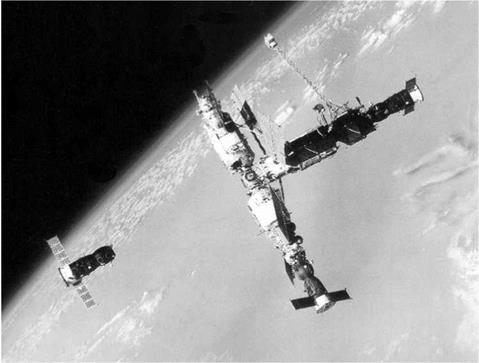. SOYUZ TM16
Flight Crew
MANAKOV, Gennady Mikhailovich, 42, Russian Air Force, commander, 2nd mission
Previous mission: Soyuz TM10/Mir EO-7 (1990)
POLESHCHUK, Alexandr Fedorovich, 39, civilian, flight engineer
Flight Log
The flight of the Soyuz TM16 spacecraft had a different background to most Soyuz ferry missions. Originally, it was intended to use the Soyuz as a one-man “rescue vehicle”, on standby for the first manned flight of the Buran Space Shuttle. If required to bring the two Buran pilots back to Earth, the Soyuz would dock with Buran’s Androgynous Peripheral Docking Assembly (APAS-89) to allow internal transfer between the two spacecraft. However, the first manned flight of Buran slipped into 1990 and the profile changed so that the Soyuz TM would dock directly with Buran and then go on to dock with Mir. Three spacecraft were ordered for rescue missions with Buran (serial numbers 101,102 and 103). Spacecraft 101 eventually flew as TM16 when it became clear that Buran would never fly with a crew aboard. The Russian space shuttle programme was finally abandoned in 1992. TM16 would also utilise the outermost docking port of the Kristall module on Mir, which was intended for use with Buran but would now be tested by TM16 in preparation for the forthcoming US Shuttle-Mir docking missions. This programme had been agreed in June 1992 between the US and Russia, as part of the Phase 1 joint space station (Freedom) programme starting in 1995.
The EO-13 resident crew was the first two-man crew since August 1990, and only the fifth two-man TM launch in 15 missions. The planned Israeli commercial flight was cancelled and no third-seat replacement was scheduled. The docking occurred without a hitch, qualifying both the system and the port for docking vehicles off the longitudinal axis of the target spacecraft. After testing the structural integrity of the seven-spacecraft combination, the crew got down to the hand-over period with the
|
The Progress M18 is shown undocked from the Mir complex, with the Progress M17 (right at the aft Kvant port) and Soyuz TM16 (bottom at the Kristall docking port) attached to the station. This photo was taken from the approaching TM17 spacecraft (ESA image) |
previous resident crew. The EO-12 crew eventually departed in TM15 on 1 February 1993.
During their busy residency, in addition to the continuing Mir science programme and normal housekeeping and maintenance chores, the Vulkan crew would work with four Progress spacecraft (Progress M15 through M18). When Progress M15 undocked, the attached Znamya (New Light, or Banner) 40 kg triangular reflector was dragged out of the rolling spacecraft by centrifugal force, unfurling to 20 m. It reflected sunlight to generate a 4,000-m-wide spot of light on Earth, demonstrating the feasibility of using space mirrors to illuminate polar regions during periods of extended darkness. The Progress later re-rendezvoused with Mir at a distance of 200 m and, using a monitor and recently fitted control columns in the Mir base block, Manakov was able to put the Progress through a series of manoeuvres to demonstrate that it was possible for a cosmonaut on Mir to automatically manoeuvre a vehicle nearby and, eventually, to dock remotely if the automatic system failed. The next Progress (M16) was undocked and re-docked by the cosmonaut using the new TORU manual docking system. M15 could not have done this, as it carried the older Znamya package.
During the first of three planned EVAs (19 Apr, 5 hours 25 minutes), the cosmonauts installed electrical drives on the side of Kvant, ready for deployable solar arrays that would be installed later. Using the Strela boom, the cosmonauts transferred one of the containers to the support framework that had been installed on Kvant during 1991. They noted that one of the Strela handles had become detached and had floated away, requiring a replacement to be shipped to Mir on the next Progress (M18). As a result, the second EVA planned for 23 April was cancelled and the third EVA became the mission’s second excursion on 18 June (4 hours 23 minutes). During this EVA, the crew repaired the boom by replacing the handle and also installed the second electrical drive. They also completed a TV documentation of the exterior of the station. The crew landed in TM16 on 22 July, along with French cosmonaut Jean-Pierre Haignere, who had arrived aboard Soyuz TM17 with the EO-14 crew for a three-week mission during the hand-over period.
Milestones
158th manned space flight
75th Russian manned space flight
23rd Russian and 49th flight with EVA operations
16th Soyuz flight to Mir
13th Mir resident crew
68th Soyuz flight
15th Soyuz TM flight
1st seven-docked-spacecraft configuration
Heaviest mass for the Mir complex to date (90 tons)
Manakov celebrates his 43rd birthday in space (1 Jun)











